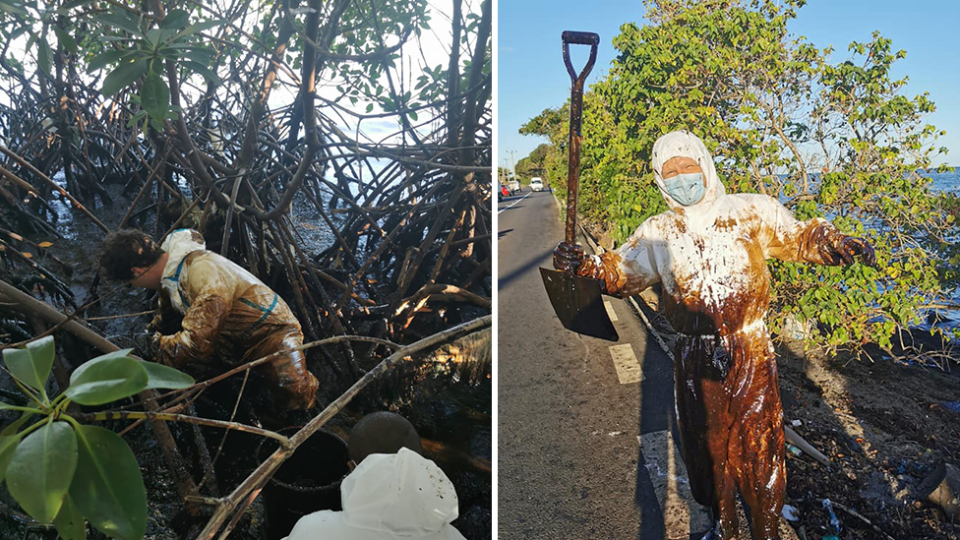'Survival instinct': Islanders scoop up oil with hands amid disaster
In a race against time, volunteers have donned heavy protective gear and ventured into thick mangroves to to protect what’s left of a pristine lagoon from an oil slick.
Tonnes of fuel has made its way towards world heritage sites on the island of Mauritius, after the Japanese-owned ship MV Wakashio, crashed into a coral reef on July 25.
While French authorities have been assisting, the majority of the cleanup is being carried out by concerned locals, toiling to protect their once untouched island paradise.


Covered in oil and exhausted from the gruelling work, volunteer Adrien Charles Duval spoke to Yahoo News Australia as he surveyed the damage to one of the mangroves.
“Well, it’s very sad because the mangrove is so important,” Mr Duval said.
“It’s like the the lungs of the ecosystem are getting completely covered with this thick toxic, smelly, deadly substance.
“It feels like however much you do, there’s still more oil coming.”
Working hard as tides threaten to spread oil
Mr Duval was working as part of a team of 85 people at Bambous Virieux, which is close to two RAMSAR wetlands – deemed to have international importance.

The region is just one of the many once untouched ecosystems now choking in oil.
As well as the environmental impact, there are grave concerns for the future of tourism, and the livelihoods of traditional fishermen who operate in the area.
As Mr Duval and his team worked, tides were threatening to spread the oil further, prompting the group to don PPE and venture into dense, steamy, mangroves.
Their fear was that if rising water levels reached the slick, it could be carried across the lagoon by ocean currents and destroy new areas.
Disturbing video shot by Mr Duval, showing volunteers scooping up handfuls of thick oil into buckets reveals just how thick the spill is.
As the volunteers stopped work for the day, the enormity of the situation was apparent.
“We’ve done as much as we can for today, but there’s so much more,” Mr Duval said.
“The weather is very dynamic on the east coast, the wind is changing direction constantly. Right now, the wind is pushing everything to the coast, but that could change.”
Concern for 100-year-old coral
The ship was believed to have spread 1000 tonnes of oil into the ocean, so despite the small team filling 50 large 260-litre barrels with oil, the area remains a disaster zone.
Mr Duval, a lawyer and politician, described the situation as “very demanding”, and said he was working in a personal capacity with his friends to clean up parts of the spill.
To prevent the remant oil spreading, large sugar cane filled nets have been placed around the coastline.

While the remaining 3000 tonnes of fuel onboard the ship are now said to be contained, local ecological strategist Sunil Mokshanand Dowarkasing believes authorities were too slow to act.
He is particularly concerned about wildlife in the area, noting there is a 100-year-old coral living at Blue Bay Marine park.
In other parts of the island, coral had just begun to regenerate after the sand extraction was banned to save local ecosystems.
'Makes me angry': Locals work to save pristine tourist island from oil devastation
Coronavirus: Concern after hundreds of face masks wash up on beach
Dead baby turtle found in 12 tonnes of rubbish removed from beach
“I feel like it's a complex feeling I have, it’s anger, disheartenment, I feel helpless at what is happening,” Mr Dowarkasing said.
“All this could have been prevented had government acted quickly from day one.
“They should have removed all the oil from the ship quickly and nothing was done for 12 days,” he lamented.
“Now for Mauritians, it’s just a survival instinct, let’s try and save the environment, let’s try and save as much as we can.”
Oil to impact area for years to come
Mr Duval fears the remnants of the disaster will haunt the island for years to come.
“Obviously there will only be oil now for the next 10 to 20 years,” he said.

“We'll have to live with the fact that we’ll have oil coming out of the sand, or we’ll get some fish that are going to move out of the area and people rely on them to make a living.
“The sad part about all of this is that this side of the island was the most pristine area of Mauritius in terms of fish variety and it was a very healthy natural reserve.
“This was the worst place to get hit,” he said.
“It’s a fight worth fighting for.”
Do you have a story tip? Email: newsroomau@yahoonews.com.
You can also follow us on Facebook, Instagram and Twitter and download the Yahoo News app from the App Store or Google Play.




